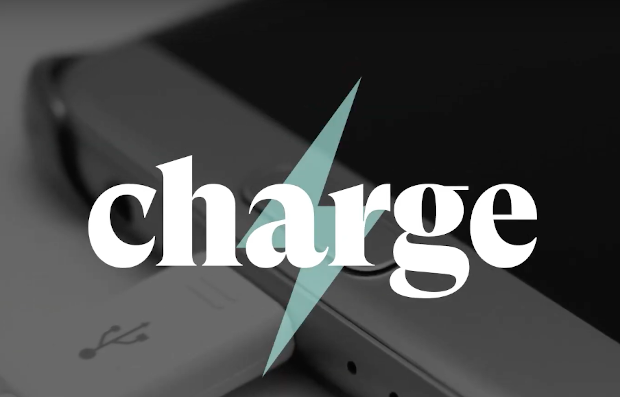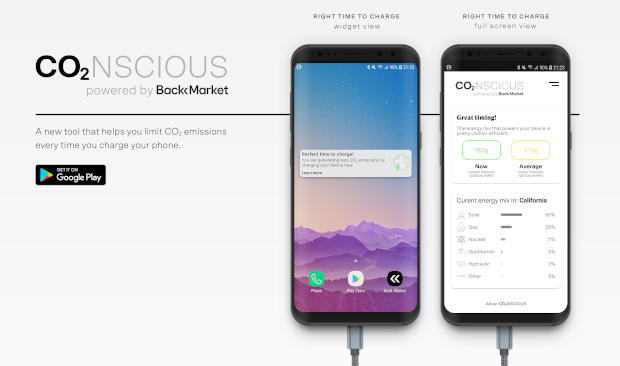
Project CO2NSCIOUS Reduces CO2 Emissions Whilst Charging Phones

Eco-conscious tech start-up, Back Market, in collaboration with BETC, presents CO2NSCIOUS: reducing CO2 emissions while charging your phone
What if we could try to reduce the environmental impact of the millions of smartphones currently in circulation? This is what Back Market offers with CO2NCIOUS, a tool which enables users to limit their CO2 emissions when charging their phones.
Back Market is a start-up that has committed to extending the life of electronic devices to fight against e-waste problems. The UK exports 24.9KG of e-waste per person, nearly twice the amount of the European Union average according to a report from the Environmental Audit Committee. Each year, Back Market offers a second life to thousands of smartphones through refurbishment, in order to use less natural resources. However, the environmental impact of phones is not only limited to manufacturing; it is also a matter of how we use them.
For example, using a smartphone uses more energy than a refrigerator, which is the most energy-consuming electronic device of a household.Being aware of the energy that powers our devices could allow us to better understand their impact on the environment.
Electricity comes from a variety of energy sources such as: coal, natural gas, nuclear power and renewables. These sources vary over the course of the day and constitute what is known as the energy mix. With the CO2NSCIOUS Android widget, Back Market allows you to know in real time the different sources of energy that power our phones, as well as their associated carbon impact. From this energy mix, CO2NSCIOUS is able to inform you of the most optimal times to recharge your device in order to generate the least CO2 emissions in the hours to come.
“The challenge here for us is to raise awareness of the ecological impact of a simple everyday gesture which consists of plugging in your phone to recharge it. It has become so natural that many are unaware of the process behind it, especially the notion of energy mix.” says Vianney Vaute, co-founder of Back Market.

Launching this tool is in line with their global mission to raise awareness to the general public about the impact of tech on the environment. The widget is also a reminder about the ever-increasing CO2 emissions. In 2007, the carbon footprint of the information and communication technology (ICT) industry represented 1% of the carbon footprint, by 2040 it will be more than 14% and smartphones are part of one of the main reason for this significant increase.

"We are not here to teach lessons, there is no 100% ecological energy or perfect smartphone. The impact of these tech products on the environment is never neutral and does not stop on the day of their production, but the way we will use them can make the difference. There is therefore, a more global job to do to change behaviours, in addition to what we do every day in through refurbishing. But if we can start by making the general public aware, it is already a first step and it starts the conversation! ” comments Vianney Vaute, co-founder of Back Market.
CO2NSCIOUS, how does it work?
Electricity production emits different amounts of CO2 depending on the energy sources that make up the energy mix. The latter is subject to change during the day. Thanks to the information provided by CO2NSCIOUS, the users are directed to the time slots during which energy consumption emits the least Co2.
The widget - available on Android - works as follows:
- Electricity map estimates the geographical origin and the sources of electricity
- IPCC (Intergovernmental Panel on Climate Change) studies are then applied to deduct the CO2 emissions associated with increasing or decreasing electricity demand. For instance,for IPCC studies are then applied to deduct the CO2 emissions associated with the increase or decrease in the demand for electricity for the sources in question
- If the user is already in an optimal timeslot ( for instance, if the rate of CO2 emission at time is the lowest in comparison with the average rate over the following six hours), CO2NSCIOUS leaves users continue to charge their device
- If the time is considered is less than optimal, CO2NSCIOUS then proposes the user to wait for a better time to recharging, within the next six hours
An initiative running for just over a month (from March 10th until April 19th at midnight) to provide a useful tool for everyone, to open the conversation, with the aim to encourage the creators of the system to take over and integrate this program in a sustainable manner.













